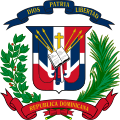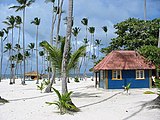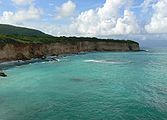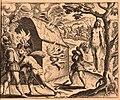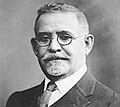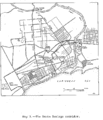Portal:Dominican Republic
Introduction
The Dominican Republic is a country on the island of Hispaniola in the Greater Antilles archipelago of the Caribbean Sea, bordered by the Atlantic Ocean to the north. It occupies the eastern five-eighths of the island, which it shares with Haiti, making Hispaniola one of only two Caribbean islands, along with Saint Martin, that is shared by two sovereign states. It is the second-largest nation in the Antilles by area (after Cuba) at 48,671 square kilometers (18,792 sq mi), and second-largest by population, with approximately 11.4 million people in 2024, of whom approximately 3.6 million live in the metropolitan area of Santo Domingo, the capital city. The Dominican people declared independence from Spain in November 1821. The colony of Santo Domingo was regionally divided with many rival and competing provincial leaders during the 1800s. Dominicans were often at war fighting against the French, Haitians, Spanish, or amongst themselves, resulting in a society heavily influenced by military strongmen. Santo Domingo attained independence as the Dominican Republic in 1844 when Dominican nationalists led an insurrection against the Haitians. Over the next decades, the Dominican Republic experienced several civil wars, battles against Haiti, and a brief return to Spanish colonial status, before permanently ousting the Spanish during the Dominican War of Restoration of 1863–1865. The U.S. occupied the Dominican Republic (1916–1924) due to threats of defaulting on foreign debts; a subsequent calm and prosperous six-year period under Horacio Vásquez followed. From 1930 the dictatorship of Rafael Leónidas Trujillo ruled until his assassination in 1961. Juan Bosch was elected president in 1962 but was deposed in a military coup in 1963. A civil war in 1965, the country's last, was ended by U.S. military intervention and was followed by the authoritarian rule of Joaquín Balaguer (1966–1978 and 1986–1996). Since 1978, the Dominican Republic has moved toward representative democracy. The Dominican Republic has the largest economy (according to the U.S. State Department and the World Bank) in the Caribbean and Central American region and is the seventh-largest economy in Latin America. Over the last 25 years, the Dominican Republic has had the fastest-growing economy in the Western Hemisphere – with an average real GDP growth rate of 5.3% between 1992 and 2018. GDP growth in 2014 and 2015 reached 7.3 and 7.0%, respectively, the highest in the Western Hemisphere. Recent growth has been driven by construction, manufacturing, tourism, and mining. The country is the site of the third largest (in terms of production) gold mine in the world, the Pueblo Viejo mine. (Full article...) Selected article -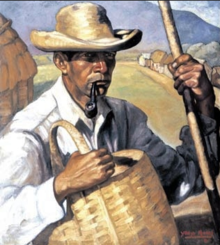 Dominican art comprises all the visual arts and plastic arts made in Dominican Republic. Since ancient times, various groups have inhabited the island of Ayíti/Quisqueya (the indigenous names of the island), or Hispaniola (what the Spanish named the island); the history of its art is generally compartmentalized in the same three periods throughout Dominican history: pre-Hispanic or aboriginal Amerindian (500 BC to 1500 AD), Hispanic or colonial (1502 to 1821 AD), and the national or Dominican period (1844 to present day). Archeological evidence for human populations on the island go back to around 6,000 years ago, when Archaic Age foragers arrived from South America to the Caribbean island. Going back to the origins of autochthonous art, corresponding to the stage known as prehistoric, primitive or pre-Hispanic, we find several ethnic groups that made up the aboriginal culture: Tainos, Igneris, Ciboneyes, Kalinago and Guanahatabeyes. Of all of them, Taino art was the majority and most widespread throughout the insular territory, leaving behind an abundance of pottery and ceramic structures. (Full article...)General images -The following are images from various Dominican Republic-related articles on Wikipedia.
Selected picture -Selected biography -Michael Francisco Pineda Paulino (born January 18, 1989) is a Dominican professional baseball pitcher who is a free agent. He has previously played in Major League Baseball (MLB) for the Seattle Mariners, New York Yankees, Minnesota Twins and Detroit Tigers. Pineda signed as an international free agent with the Mariners in 2005, and made his MLB debut for the Mariners in 2011. In his rookie season he was named an All-Star and finished fifth in balloting for American League Rookie of the Year. After his rookie season, he was traded to the Yankees. He missed the 2012 and 2013 seasons due to a series of shoulder injuries. Pineda's 2017 season ended when he underwent Tommy John surgery, which kept him out for the entire 2018 season. He returned to MLB with the Twins in 2019 and signed with Detroit for the 2022 season. (Full article...)Related portalsWikiProjects
Things to do
Associated WikimediaThe following Wikimedia Foundation sister projects provide more on this subject:
SourcesDiscover Wikipedia using portals | |||||||||||||||||||||||||

